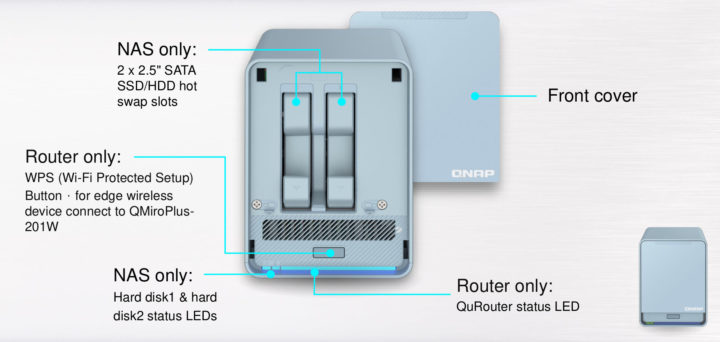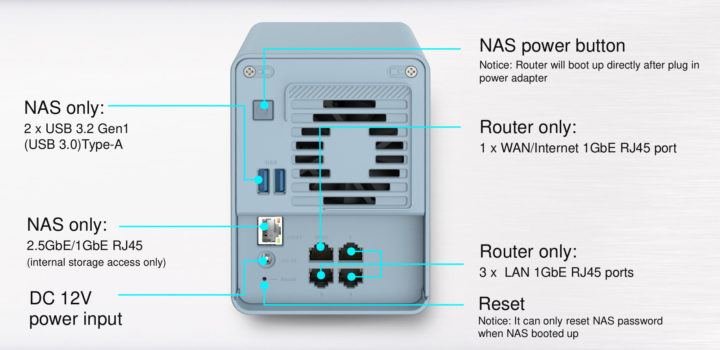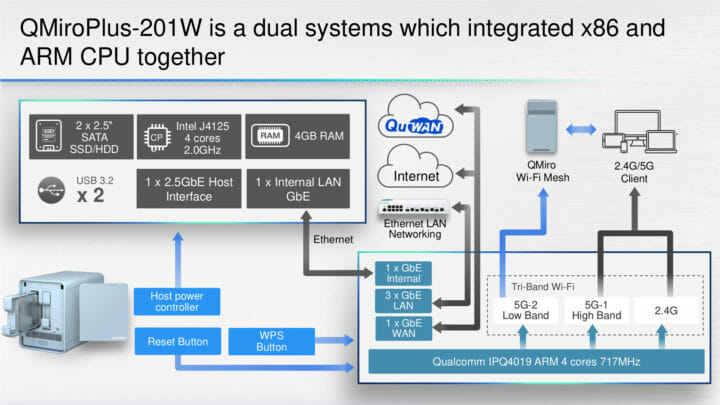QNAP QMiroPlus-201W is an unusual networked storage device that’s acting both as a 2.5GbE & WiFI 6 router and NAS combining Qualcomm IPQ4019 Arm SoC for the router functions, and an Intel Celeron J4125 quad-core Gemini Lake processor for the NAS functions.
Usually, you’d get the choice of either an Arm or Intel processor, but here QNAP decided to use both to keep the same performance as having separate Arm-based router and Intel-based NAS, but in a much more compact form factor.
QNAP QMiroPlus-201W hardware specifications:
- SoC/memory/internal storage
- Data Storage – 2x 2.5-inch SATA 3Gb/s (Compatible with 6Gb/s SSD/HDD) bay
- Networking
- 1x 2.5GbE host port (NAS only)
- 4x Gigabit Ethernet RJ45 ports (Router only)
- 802.11a/b/g/n/ac WiFi 6 rated AC2200
- 2.4 GHz 2×2 MIMO up to 400 Mbps
- Dual-band 5 GHz 2×2 MIMO up to 867+867 Mbps (1734 Mbps)
- 4x Internal Antennas
- WiFi Mesh supported
- Bluetooth 5
- USB – 2x USB 3.2 Gen 1 ports (for the NAS only)
- Misc – Button Power(for NAS), Reset, WPS
- Power Supply – 12V DC
- Power consumption – 60W max
- Dimensions – 183.5 x 105 x 143.5 mm
- Weight – 1.44Kg
- Operating Temperature – 0°C ~ +40°C
- Operating Humidity – 5% to 95% non-condensing
- Certifications – JATE / CE / FCC / BSMI / NCC / IC / SRRC / CCC / VCCI / RCM / OFCA
So what we end up having in this device are two separate products with an Intel NAS and an Arm router having separate ports, but at least they share the same power input… It looks to be possible to turn off the NAS, while the router is on as long as the system is plugged into the main.
The router runs QTS smart home management storage system on the NAS subsystem and QuRouter on the router subsystem. The solution supports WiFi Mesh through QMiro-201W units to extend coverage, QuWAN to connect the company network with your home network through SD-WAN, and can also be managed through QuRouter app.
Tri-band WiFi does not mean WiFi 6E here, and instead, it appears QNAP QMiroPlus-201W relies on the same 5.0 and 5.8 GHz bands as Xiaomi Mi AX9000 “WiFI 6 Enhanced” router.
QNAP uploaded a 44-minute video presentation of the NAS router last month, but if you are short on time you could also flick through the presentation slides.
At the point in time, I could only find QNAP QMicroPlus-210W in some shops in Australia for 904.82 AUD inc. VAT ($700 US) and the Czech Republic for 13,439 K ($644 US). Additional information may be found on the product page.
Thanks to TLS for the tip.

Jean-Luc started CNX Software in 2010 as a part-time endeavor, before quitting his job as a software engineering manager, and starting to write daily news, and reviews full time later in 2011.
Support CNX Software! Donate via cryptocurrencies, become a Patron on Patreon, or purchase goods on Amazon or Aliexpress







